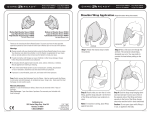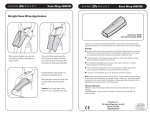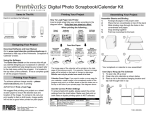Download new manual.cdr - tec
Transcript
TAYLOR WHARTON LOW LEVEL ALARM Type: M284CE For Liquid Nitrogen Refrigerators SAFETY Before using this accessory it is essential that you read the Handle with Care booklet (TW-10) provided with the unit. This details safety precautions that must be read and understood before using the equipment. Do not touch liquid or cold metal surfaces with your bare skin. The liquid nitrogen used in cryogenic refrigerators is extremely cold: -320°F ( -196°C). Exposure of skin or eyes to liquid, cold gas, or frosted parts could result in a severe frostbite-like injury. Use only the necktube core provided with this accessory or the one originally supplied with the refrigerator. A tight fitting plug or stopper will cause a pressure increase in the container that may damage the container and/or cause personal injury. 1 The Low Level Alarm is an optional accessory for selected models of portable liquid nitrogen refrigerators. It is designed to activate visual and audible alarms when the liquid nitrogen level in the refrigerator drops below a pre-set level, usually 25 percent of container capacity. This automatic monitoring system provides protection when high-value materials are stored under liquid nitrogen refrigeration. The Low Level Alarm consists of three components: 1)Alarm Module 2)Power Supply Module 3)Sensor/Necktube Core The Alarm and Power Supply Modules are common to all systems, while the Sensor/Necktube Core is specially designed for specific refrigerator models. Sensor Module Connection Type: M284CE Alarm Module Remote Alarm Connection Type: M286CE Power Supply 220/240 VAC Figure 1: Low Level Alarm Components 2 INSTALLATION There is no need to empty the refrigerator before installing the Low Level Alarm. In fact, the container will need to be at least 25% full of liquid nitrogen to properly test the Alarm after the installation is completed. The Alarm Module (Figure 1) mounts on top of the refrigerator lid, using adhesive velcro strips. Ensure that the lid is clean and dry before proceeding. Do not allow the Module to touch the lid until it is in the exact spot for proper mounting; once the strip sticks, it can not be moved. Carefully centre the Module over the name plate on the refrigerator lid. Be sure that the connectors are toward the hinge side of the lid. Remove the protective covering from the adhesive strips on the back of the Alarm Module. Press the Module firmly into place. Open the refrigerator lid and remove the existing necktube core. Slowly insert the Alarm Sensor necktube straight down into the refrigerator. Handle the sensor carefully to avoid possible damage to the probe. Route the sensor cable out through the lid hinge opening. Check that the wire is not pinched under the lid when it is closed. Insert the sensor cable plug into the socket on the Alarm Module. Connect the module power cable to the power supply. Connect the power cord to a suitable AC power outlet. NOTE: The power supply is factory set to use the alarm with 220 / 240 VAC. The installation of the Low Level Alarm is now complete. Perform the test procedure described under 'Operation'. NOTE: If a remote alarm device is to be used, see Figure 2 for connection details. A cable connector for the remote alarm is supplied. 3 ALARM MODULE REMOTE ALARM TYPICAL CIRCUIT 1 Remote Alarm 2 Relay AC Power Source 3 Figure 2. Remote Alarm Connections ALARM RELAY REMOTE ALARM CONNECTOR 1 GREY 2 ORANGE 3 VIOLET NOTE: 3 1 2 1) Contacts 1 and 2 are closed during normal operation. 2) Contacts 2 and 3 are closed during alarm condition. 3) Maximum contact ratings for relay: 50V AC/DC, 2 AMPS MAX OPERATION General Once the Low Level Alarm is installed, it requires operator attention only when the liquid level in the container falls below the alarm sensor. At that point, the alarms are activated and operator response is required. When the alarm senses low liquid, the red indicator flashes at a rapid rate, the audible alarm emits a pulsating tone. To silence the audible alarm, press the pushbutton on the top of the Alarm Module. The red indicator will continue to flash rapidly until the container is refilled or the sensor is disconnected. After 15 minutes of low liquid level the optional remote alarm device is activated. To refill the container, disconnect the sensor plug from the Alarm Module, open the lid and remove the sensor necktube core. The red indicator will be lit continuously until the sensor is reconnected. If the sensor plug is not reconnected to the alarm module within 15 minutes, the audible alarm will emit a pulsating tone. Pressing the pushbutton will silence the alarm. After a further 15 minutes, if the sensor plug is not reconnected, the optional remote alarm device is activated. Add liquid as required to fill the container. Then slowly replace the sensor necktube core and connect it to the Alarm Module. The red indicator will go out, then flash once every few seconds. NOTE: When the liquid level is above the alarm sensor the red indicator flashes once every few seconds to indicate the Alarm Module is connected to a power source. 4 OPERATIONAL TEST To check the operation of the Low Level Alarm. NOTE: The sensor is positioned so that the alarms are activated when liquid level falls below approximately 25% of the container capacity. For accurate test results, be sure the container liquid level is at least 33% full. 1) Disconnect the sensor cable from the Alarm Module. The red indicator should be lit continuously 2) Reconnect the sensor cable. The red indicator should go off, then flash once every few seconds. 3) Press the pushbutton on the top of the Alarm Module. The red indicator and the audible alarm should pulse on and off at a rapid rate. When the pushbutton is released, the indicator and audible alarm should go off. The indicator will flash once every few seconds. 4) To test the optional remote alarm device, press the pushbutton and hold it down. After approximately 15 seconds, the remote alarm device should be activated. When the pushbutton is released, all alarms should cease operation. 5) If all functions operate as described, the Low Level Alarm is functioning normally. If a malfunction is indicated, refer to your distributor. 5






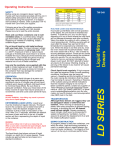


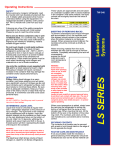
![TSD Series -40C ULT User Manual [EN]](http://vs1.manualzilla.com/store/data/005634658_1-66c9db561a67486106446026c707a26c-150x150.png)



